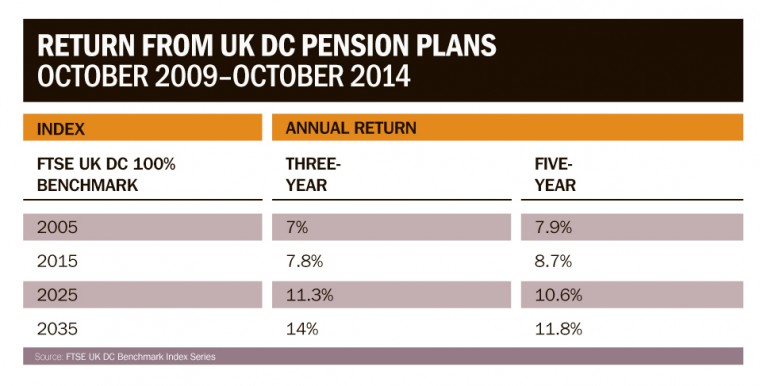While it is notoriously difficult to measure returns from defined contribution (DC) schemes, since few plans are alike, a new industry index is making the job easier and it paints a positive picture.
In October this year, the FTSE Benchmark Index Series published performance from two standard DC strategies – one based on a traditional lifestyle approach, the other on target date funds – and provides returns for the past five years for a range of expected retirement dates. The table shows investors have enjoyed returns of at least 7 per cent in the past five years, while those with longer time horizons boasted 14 per cent.
Default investment strategies, into which members are invested if they make no active decisions themselves, have been heavily exposed to equities and have rewarded investors well in recent years.
But investment in equities demands a stomach for choppy markets and increasingly, particularly with the advent of auto-enrolment, trustees and providers recognise that a smoother savings journey may be required.
Default strategies set up under the auto-enrolment legislation have started to include diversified growth funds (DGFs) which are designed to manage risk better while providing growth.
GREATER RISK MANAGEMENT
Stephen Bowles, head of DC at asset manager Schroders, says: “The focus has switched from growth with a bit of risk management to a lot of risk management with less growth.”
However, risk management comes at a price. DGFs are actively managed and require regular monitoring and adjusting, meaning fees often far exceed those of the passively managed index fund.
This is particularly problematic for schemes that included DGFs in their auto-enrolment default funds, only to then exceed the government’s recent 75 basis point (0.75 per cent) charge cap.
Mr Bowles says: “Clients are unpicking multi-asset funds above the charge cap in favour of lower-cost strategies. This could mean that some schemes are unwinding positive work, which was good for members, simply because of the charge cap.”
Employers also need to rethink default strategies following the government’s decision to allow greater freedom for DC savers in retirement.
After April next year, DC savers will be able to draw their retirement income almost with impunity, meaning investment strategies that assume members will purchase an annuity at retirement could prove outdated.
The focus has switched from growth with a bit of risk management to a lot of risk management with less growth
Research from pensions adviser Intelligent Pensions, which surveyed 163 trustees and pension managers in October, found that 94 per cent of schemes’ investment strategies still target annuities, which is at odds with their belief that just one in three members would choose to buy these products.
Andrew Pennie, marketing director at Intelligent Pensions, says: “There is no doubt many DC pension members are using an investment strategy that is totally at odds with what they are likely to do at retirement.”
So both trust and contract-based DC schemes need to revise traditional lifestyle default strategies and find approaches that allow members in the latter stages of saving to remain invested in the markets, without leaving them unnecessarily exposed to risks which could erode their pots irrevocably.
Rona Train, senior investment consultant at Hymans Robertson, says: “We are creating strategies that match the pre-retirement piece as closely as possible with what we think the post-retirement choice will be. The industry is working towards a seamless transition, so anyone wanting to take income drawdown moves into a diversified income fund in the last few years before retirement.”
Increasingly target date funds (TDFs) are seen as a default solution, since these can offer low cost and flexibility.
TDFs see members invested in a fund based on a predetermined retirement date. The funds are then dynamically adjusted to keep members on course to meet their retirement goals at the specified date.
The National Employment Savings Trust, a catch-all DC pension provider, is a keen supporter of TDFs and uses these as a foundation for its default strategy.
Simon Chinnery, head of DC at JPMorgan, which offers TDFs, says: “We don’t yet know exactly what the UK pension market will look like in five years, so it is paramount to have investments dynamic enough to change and evolve with the market. This means target date funds, since lifecycle is too inflexible and slow to adapt.”
DC investment strategies will always face a challenge as they attempt to apply a one-size-fits-all approach to a wide range of individuals. This has been further complicated by allowing greater freedom at retirement and the imposition of a charge cap.
However, DC now has the potential to prove itself a valuable retirement savings vehicle, and it is up to advisers and providers to ensure products and strategies rise to the challenge.

